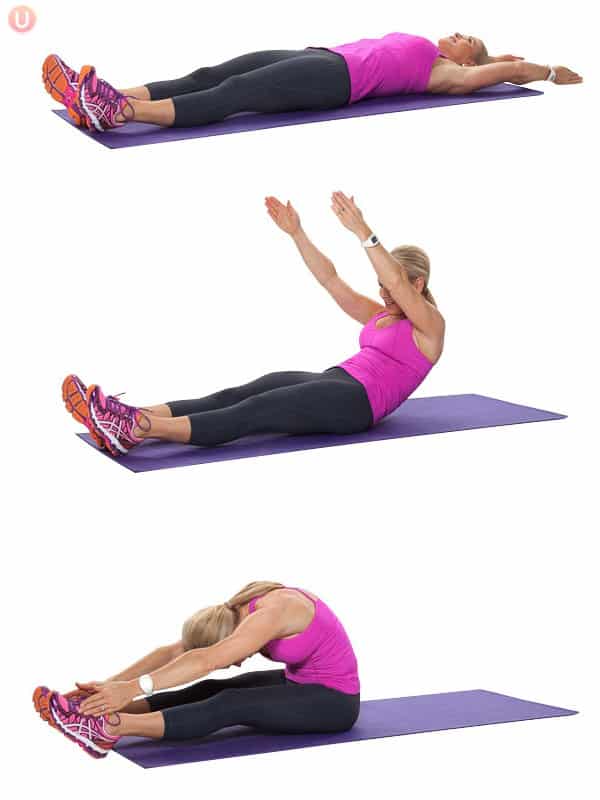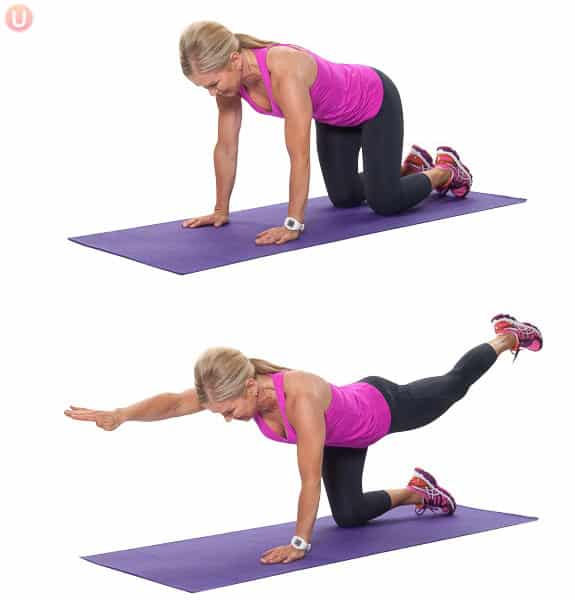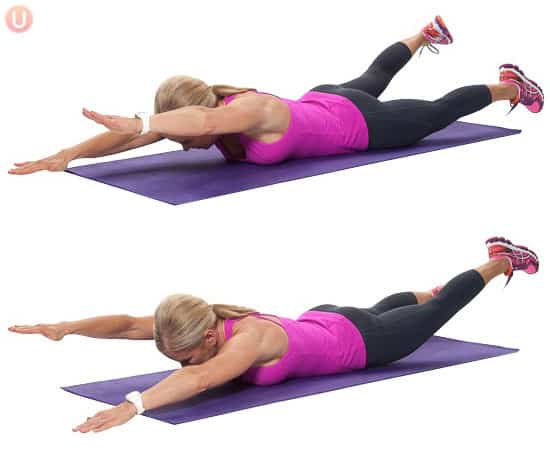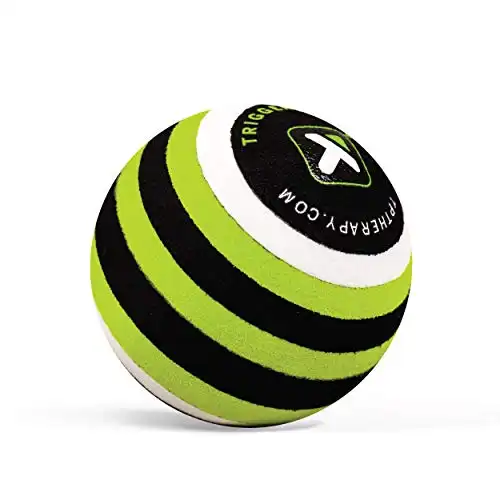This post contains affiliate links. Please see our disclosure policy.
The right back pain exercises can relieve, stretch, and strengthen your back muscles to decrease pain levels, improve range of motion, and keep chronic back pain at bay. Take it from a fitness expert, even though back pain is a common problem, simple exercises and gentle stretching are a great way to keep your entire body pain free!
Back pain is incredibly common. It used to be something we only thought of when thinking of older populations, but it’s impacting almost everyone now. Studies show that nearly 80% of people will suffer from lower back pain at some point.
This frustrating pain impacts lots of different lifestyles. Both overly sedentary and active lifestyles can suffer from a back problem.
Overly sedentary lifestyles with little activity tend to spend a lot of their day sitting at a desk. Their lack of regular exercise causes an achy back. This contributes to tight hip-flexors, poor posture, weak abdominals, and stiff sedentary muscles. Who would have thought your work day could be the cause of your pain?
On the other hand, over active people are running into issues as well. These people get lots of physical activity and tend to have rigorous fitness schedules. They are running and jumping on a repetitive schedule, which puts pounding bodyweight pressure on their lower spine. Skipping a good stretch post-workout usually compounds the issue.
If you don’t quite fall into either category, you’re not quite in the clear. Many people suffer from back pain issues triggered by regular parts of their life. There is a pretty good chance you might fall into a few of these risks. A few examples are bad mattresses, poor walking posture, standing too much, sitting too much, repetitive golf or tennis swings, and the list goes on.
In a world where almost every activity leaves us at risk for back pain, it’s time to get to the solution! The good news is, adding back pain exercises and simple stretches to your weekly routine can help relieve existing pain, and prevent future issues with lower back muscles.
Table of contents
Common Causes of Back Pain
There are many common causes of back pain. The pain can also become acute, or chronic. Acute pain is short-term (lasting six months or less), while chronic pain lasts longer than six months. If you are experiencing a severe level of either type of back pain, we recommend seeking professional medical advice.
Some of the most common causes of back pain include:
- Arthritis
- Disc Problems
- Lifestyle Triggers
- Scoliosis
- Muscle Sprains, Strains, Spasms

Lower Back Pain Causes
Lower back pain is the most common. There are many spine-related conditions that cause low-back pain, including: arthritis, ruptured discs, disc regeneration, osteoporosis, pinched nerves, scoliosis, torn or pulled muscles, and vertebrogenic pain.
It can also stem from unresolved hips or pelvis issues. Our lower backs, hops and pelvis all work together. If there is an issue with any of those parts, it can cause symptoms in another.
Upper Back Pain Causes
Upper back pain tends to be less common. Sitting at a desk or non-ergonomic setting for long periods of time with poor posture can lead to upper back and neck pain. Office workers tend to experience this. When we have a forward-bending posture it puts additional pressure on bones, discs, muscles and ligaments in our upper spine.
Upper back pain can also stem from shoulders. Rotator cuff tears, bursitis, and scapular dyskinesis are all top contenders.
How to Relieve Back Pain
If you’ve ever wanted to break up with your back pain, you’re not alone. A whopping 80% of Americans deal with back pain at some point in their life, whether from chronic low back pain or injury. It’s so common, we created a whole guide for how to get rid of back pain.
Some of the most common ways to treat back pain are:
- Yoga poses
- Foam roller
- Massage ball
- Hot or cold therapy
- Infared light therapy
- Physical exercises
There are bandages you can put on back pain, but movement is truly the best medicine.
| Product Image | Product Name | Primary Button |
|---|---|---|
How Exercise Can Help With Back Pain
Moving your body might be the last thing you’re thinking of with back pain. But the truth is, exercise is the number one prescription for many instances of back pain. If you’re dealing with chronic aches or pains from poor posture, or simply getting older, exercises for back pain can be a good idea.
Back pain exercises work wonders by helping to:
- Promote disc health
- Decrease stiffness
- Strengthen muscles
Adding simple back pain exercises to your routine can help strengthen your back muscles, and the surrounding muscles that help support it. For example, stomach muscles and hip flexor muscles help with posture. And, it’s actually our leg muscles that support our backs while we move. All of our muscles work together, so it’s critical to do the right low-impact exercise to keep them strong!
The Best Back Pain Exercises
Whether you are trying to fix back pain or avoid it, we’ve got the five best exercises for you.
No matter what the cause, back pain can be helped by two things:
- Stretching the back and legs
- Strengthening the entire core
Use proper form to practice the following five back pain exercises on a weekly or bi-weekly basis and get rid of that aching back.
Before starting any new exercises we always recommend checking in with your healthcare provider of choice if you have any concerns.
Full Body Roll-Up
The full body roll-up exercise strengthens your core in a slow, controlled motion. It teaches you to articulate your spine, and stretches the muscles in the back and legs that cause tightness in the back.

How To Do A Full Body Roll-Up:
- Lie flat on your back with your arms extended overhead.
- Inhale arms to the sky, exhale and slowly roll up into a “C” curve reaching for your toes. (Think about threading your belly button to your spine to activate your transverse abdominus.)
- Inhale and start to slowly go back in a C curve.
- Exhale as you uncurl your body one vertebra at a time back into the mat.
Be sure to keep your feet on the ground as you move slowly. Perform 6-8 roll-ups.
Bird Dog
The bird dog exercises teaches your body to use the core for stability. It strengthens your ab muscles and low back, and lengthens the spinal column for better posture.

How To Do A Bird Dog:
- For a starting position, kneel on the mat on all fours.
- Reach one arm long, draw in the abdominals, and extend the opposite leg long behind you.
- Repeat on the other side.
Perform 8-10 per side. Move slow and steady, holding arm and leg out momentarily before switching.
Forearm Plank
The forearm plank strengthens all of your core muscles. It engages your stabilizers while lengthening and improving posture.

How To Do A Forearm Plank:
- Begin lying on the floor with your forearms flat on the floor, making sure that your elbows are aligned directly under your shoulders.
- Engage your core and raise your body up off the floor, keeping your forearms on the floor and your body in a straight line from head to feet. Keep your abdominals engaged and try not to let your hips rise or drop.
Hold forearm plank for 30 seconds to start, trying to progress to a 60 second hold.
Swimming Exercise
The swimming exercise strengthens back extensors while teaching core muscles to grip during movement. It’s a great way to engage your core!

How To Do The Swimming Exercise:
- Lie on your stomach with the legs and arms extended. Engage your abdominals so you feel your transverse abdominis contract.
- Lift your arms and legs off the floor and keep your nose in a hover above the mat. Flutter your arms and legs, moving from the hips and shoulders (not the knees and elbows) like you are swimming.
The goal is to keep the body stable as the limbs flutter quickly. Try for 30 seconds and work your way up to 60 seconds.
Child’s Pose
Child’s pose is a the best way to promote relaxation while stretching your back. It’s technically a stretch, but you won’t regret it!

How To Do Child’s Pose:
- Begin with hands and knees on the mat, knees separated to the outer edges of the mat.
- Sit your tailbone down and back between your heels and lower your belly between your thighs.
- Stretch your arms long in front of you and relax your forehead onto the mat. Breathe fully and hold as long as you’d like.
Technically this is a stretch not an exercise, but you don’t want to leave this off your list. The relief feels amazing. Hold for 30 second to 1 minute.
Adding targeted back pain exercises to your weekly routine is one of the best ways to help existing back pain and prevent future injury. This simple adjustment to your exercise routine can help you maintain an active healthy lifestyle for years to come.







The “Full Body Roll-up” will further tighten the hip-flexors, which your article pointed out was a problem for “Susan,” and it also puts tremendous pressure on the discs as you lift up. One of the worst exercises you could do if you had any back pain.
We appreciate your comment and agree with you depending on what your back pain is all about. Doing full body roll-ups and Pilates can be beneficial for some back issues. For my personal back pain, full body roll-ups help me stretch my back and make it stronger as well as strengthen my core to protect my back. I have a completely degenerated disc between L4 and L5 but no nerve issues. Bottom line, always consult with your doctor and/or physical therapist first … as everyone’s back pain is different.
I’m 45 years old and I can say that streches, physiotherapy and exercises are must, if you want to treat sciatica. I had a severe form of it, but now it’s gone.
I’m a busy person, so I had no time for physical therapy at hospital or rehab centre. I didn’t know what to do back then, the pain was killing me… So, I did a research and found an alternative treatment which don’t require me a lot of time and money.
It’s an e-book, written by a former sciatica sufferer. I admit, I learned a lot from him. He taught me almost everything about sciatica and how to cure it. I followed everything carefully and I’ve got prompt results – I completely got rid of sciatica in only 1 week. Crazy right? Till now it’s not coming back, so I started to think that the result was permanent.
I recommend every sciatica sufferer to read this e-book because it does wonders. I’m leaving a link to a review of that e-book:
www*dietandhealthreviews*com/sciatica-sos-review
( be sure to replace * with a dot, because I can’t post links here, sorry )
Completely agree with Mike. Should not be attempted under any circumstances by anyone. The body roll is basically just a version of the old school PE sit up – which has probably been responsible for a whole generation of middle aged back problem sufferers. Best case scenario, if you could keep your heels on the floor and use the strength of your stomach muscles to lift your torso, then it would do your back no harm. But that’s virtually impossible. If it was possible, it would only benefit your stomach muscles – which wouldn’t need it if they were already strong enough to lift your torso while keeping your heels on the floor